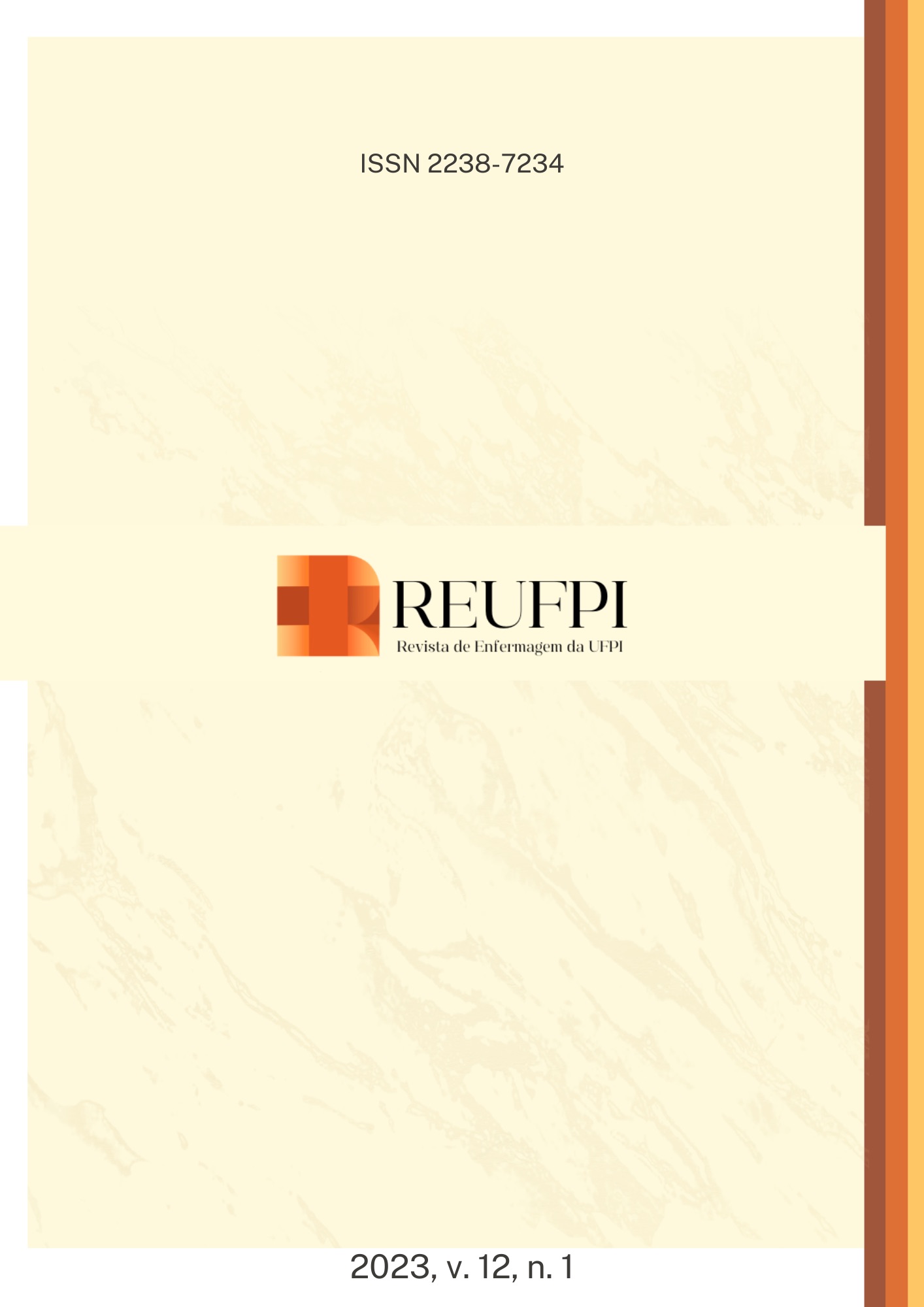Coverings and topical agents and their effects on the treatment of venous lesions: integrative review
DOI:
https://doi.org/10.26694/reufpi.v12i1.3868Keywords:
Enfermagem, Úlcera Varicosa, Úlcera da Perna, Terapêutica, Curativos OclusivosAbstract
Objetivo: Identificar na literatura coberturas e agentes tópicos utilizados no tratamento de lesões venosas e descrever os efeitos encontrados. Métodos: Revisão integrativa da literatura, realizada em bases de dados nacionais e internacionais, com uso dos seguintes descritores: úlcera varicosa; úlcera da perna; curativos oclusivos; terapêutica e suas respectivas traduções em inglês. Incluíram-se artigos publicados no período entre 2014 e 2022, sem limitação de idioma. Resultados: Identificaram-se 22 agentes tópicos/coberturas nos 24 artigos selecionados, com predomínio da carboximetilcelulose (n=4), gel de papaína (n=3) e polihexametileno biguanida (n=2), gel de plaquetas (n=2) e tecnologia como lipido-coloide-nano oligossacarídeo (n=2). Conclusão: Os 22 agentes tópicos/coberturas encontrados foram capazes de acelerar a cicatrização, diminuir o exsudato e tecidos desvitalizados, controlar a carga bacteriana, modular a inflamação e reduzir a dor e o odor. A partir da pesquisa também se identificaram as indicações, os resultados e as recomendações dos agentes/coberturas. Entretanto, ressalta-se a importância da realização de pesquisas clínicas de qualidade que contribuam para o planejamento e a tomada de decisões na assistência de enfermagem às pessoas com lesões venosas.
References
Sánchez-Nicolat NE, Guardado-Bermúdez F, Arriaga-Caballero JE, Torres-Martínez JA, Flores-Escartín M, Serrano-Lozano JA, et al. Revisión en úlceras venosas: Epidemiología,
fisiopatología, diagnóstico y tratamiento actual. Rev Mex Angiol [Internet]. 2019; 47(1):26-38. Disponível em: https://www.medigraphic.com/pdfs/revmexang/an-2019/an191d.pdf
Sales FAAS, Siqueira MS, Specht AM, Treviso P. Úlceras varicosas: Revisão integrativa acerca de recomendações de cuidado de enfermagem. Nursing (São Paulo) [Internet]. 2022; 25(289):7904–17. Doi: https://doi.org/10.36489/nursing.2022v25i289p7904-7917
Sousa MBV, Bezerra AMFA, Costa CV, Gomes EB, Fonseca HTA, Quaresma OB, et al. Assistência de enfermagem no cuidado de feridas na atenção primária em saúde: revisão integrativa. REAS [Internet]. 2020; (48):e3303. Disponível em: https://acervomais.com.br/index.php/saude/article/view/3303
Joaquim FL, Silvino ZR, Souza DF, Souza CJ. Care management for people with venous ulcers from the perspective of health quality. RSD [Internet]. 2020; 9(5):e106953190. Disponível em: https://rsdjournal.org/index.php/rsd/article/view/3190
Rodrigues LM, Oliveira BGRB, Castilho SR, Futuro DO. Health technology assessment: use of carboxymethylcellulose 2% in treating leg ulcers. Rev enferm UERJ [Internet]. 2015;23(4):520–5. Doi: http://dx.doi.org/10.12957/reuerj.2015.4110
Arksey H, O'Malley L. Scoping Studies: Towards a Methodological Framework. Int J Soc Res Methodol Theory Pract [Internet]. 2005;8:19–32. Doi: https://doi.org/10.1080/1364557032000119616
Agencia para la Investigación y la Calidad de la Atención Médica (AHRQ). Mejora y seguimiento de la calidad a su alcance. Rockville: Agencia para la Investigación y la Calidad de la Atención Médica, 2016.
Atias Z, Pederson JM, Mishra HK, Greenberger S. The effect of natural matrix biopolymer membrane on hard-to-heal venous leg ulcers: a pilot randomised clinical trial. J Wound Care [Internet]. 2020; 29(5). Doi: https://doi.org/10.12968/jowc.2020.29.5.295
Barrett S, Rippon M, Rogers AA. Treatment of 52 patients with a self-adhesive siliconised superabsorbent dressing: a multicentre observational study. J Wound Care [Internet]. 2020;29(6):340-9. Doi: https://doi.org/10.12968/jowc.2020.29.6.340
Boey J, Tang TY, Galea E. Management of venous leg ulcers with a two-layer compression bandage and a polyacrylate fibre dressing. Wound Practice & Research [Internet]. 2020;28(3):127-32. Doi: https://doi.org/10.33235/wpr.28.3.127-132
Dissemond J, Augustin M, Dietlein M, Faust U, Keuthage W, Lobmann R, et al. Efficacy of MMP-inhibiting wound dressings in the treatment of chronic wounds: a systematic review. J Wound Care [Internet]. 2020;29(2):102-18. Doi: https://doi.org/10.12968/jowc.2020.29.2.102
Murray S, Norrie L. Reducing variation in care: Implementation of a leg ulcer pathway including treatment with UrgoStart Plus and UrgoKTwo compression system. Wounds UK [Internet]. 2020;16(1):106-13. Disponível em: https://www.wounds-uk.com/journals/issue/608/article-details/reducing-variation-care-implementation-leg-ulcer-pathway-including-treatment-urgostart-plus-and-urgoktwo-compression-system
Zhao M, Zhang D, Tan L, Huang H. Silver dressings for the healing of venous leg Ulcer A meta-analysis and systematic review. Medicine (Baltimore) [Internet]. 2020;99(37):e22164. Doi: https://doi.org/10.1097/MD.0000000000022164
Oropallo AR. Use of native type i collagen matrix plus polyhexamethylene biguanide for chronic wound treatment. Plast Reconstr Surg Glob Open [Internet]. 2019;7(1):1–6. Doi: https://doi.org/10.1097/GOX.0000000000002047
Barrett S, Callaghan R, Chadwick P, Haycocks S, Rippon M, Stephen-Haynes J, et al. An observational study of a superabsorbent polymer dressing evaluated by clinicians and patients. J Wound Care [Internet]. 2018;27(2):91-100. Doi: https://doi.org/10.12968/jowc.2018.27.2.91
Mataro I, Giudice G, D’Alessio R, Maggio G, Vestita M. The use of nexobridTM in debriding chronic ulcers: A preliminary observational study. Ann Burns Fire Disasters [Internet]. 2018;31(2):109–12. Disponível em: https://www.ncbi.nlm.nih.gov/pmc/articles/PMC6199007/
Morilla-Herrera JC, Morales-Asencio JM, Gómez-González AJ, Díez-De Los Ríos A, Lupiáñez-Pérez I, Acosta-Andrade C, et al. Effectiveness of a hydrophobic dressing for microorganisms' colonization of vascular ulcers: Protocol for a randomized controlled trial (CUCO-UV Study). J Adv Nurs [Internet]. 2020;76(8):2191–7. Doi: https://doi.org/10.1111/jan.14412
Pinheiro RR, Duarte B, Cabete J. Trichloroacetic acid (80%) as a chemical debridement method for chronic venous leg ulcers - A pilot study. Int Wound J [Internet]. 2018;15(3):438–40. Doi: https://doi.org/10.1111/iwj.12884
Semenič D, Cirman T, Rožman P, Smrke DM. Regeneration of chronic wounds with allogeneic platelet gel versus hydrogel treatment: A prospective study. Acta Clin Croat [Internet]. 2018;57(3):434–42. Doi: https://doi.org/10.20471/acc.2018.57.03.05
Mancini S, Cuomo R, Poggialini M, D’Aniello C, Botta G. Autolytic debridement and management of bacterial load with an occlusive hydroactive deressing impregnated with polyhexamethylene biguanide. Acta Biomed [Internet]. 2017;88(4):409–13. Doi: https://doi.org/10.23750/abm.v88i4.5802
Oliveira MG, Abbade LPF, Miot HA, Ferreira RR, Deffune E. Estudo piloto do gel de plaquetas homólogo no tratamento de úlceras venosas. An Bras Dermatol [Internet]. 2017;92(4):499-504. Doi: http://dx.doi.org/10.1590/abd1806-4841.20175496
Araújo ICF, Defune E, Abbade LPF, Miot HA, Bertanha M, Carvalho LR, et al. Fibrin gel versus papain gel in the healing of chronic venous ulcers: A double-blind randomized controlled trial. Phlebology [Internet]. 2017;32(7):488–95. Doi: https://doi.org/10.1177/0268355516664808
Caridi G, Massara M, Acri I, Zavettieri S, Grande R, Butrico L, et al. Trophic effects of polynucleotides and hyaluronic acid in the healing of venous ulcers of the lower limbs: A clinical study. Int Wound J [Internet]. 2016;13(5):754–8. Doi: https://doi.org/10.1111/iwj.12368
Januário V, Ávila DA, Penetra MA, Sampaio ALB, Noronha Neta MI, Cassia FF, et al. Evaluation of treatment with carboxymethylcellulose on chronic venous ulcers. An Bras Dermatol [Internet]. 2016;91(1):17-22. Doi: https://doi.org/10.1590/abd1806-4841.20163789
Murphy N. Reducing infection in chronic leg ulcers with an activated carbon cloth dressing. Br J Nurs [Internet]. 2016; 25(12):S38-44. Doi: https://doi.org/10.12968/bjon.2016.25.12.S38
Serena T, Connell H, McConnell S, Patel K, Doner B, Sabo M, et al. Novel Multivalent Wound-Healing Ointment Provides Bioburden Control and Moisture Management: A Retrospective Registry Data Analysis. Adv Ski Wound Care [Internet]. 2016;29(10):461–8. Doi: https://doi.org/10.1097/01.ASW.0000490193.96840.9e
Moreno-Eutimio MA, Espinosa-Monroy L, Orozco-Amaro T, Torres-Ramos Y, Montoya-Estrada A, Hicks JJ, et al. Enhanced healing and anti-inflammatory effects of a carbohydrate polymer with zinc oxide in patients with chronic venous leg ulcers: Preliminary results. Arch Med Sci [Internet]. 2018;14(2):336–44. Doi: https://doi.org/10.5114/aoms.2016.59851
Ribeiro APL, Oliveira BGRB, Soares MF, Barreto BMF, Futuro DO, Castilho SR. Effectiveness of 2% and 4% papain gels in the healing of venous ulcers. Rev da Esc Enferm USP [Internet]. 2015;49(3):394–400. Doi: https://doi.org/10.1590/S0080-623420150000300006
Rodrigues ALS, Oliveira BGRB, Futuro DO, Secoli SR. Effectiveness of papain gel in venous ulcer treatment: randomized clinical trial. Rev Lat Am Enfermagem [Internet]. 2015;23(3):458–65. Doi: https://doi.org/10.1590/0104-1169.0381.2576
Ghatnekar GS, Grek CL, Armstrong DG, Desai SC, Gourdie RG. The Effect of a Connexin43-Based Peptide on the Healing of Chronic Venous Leg Ulcers: A Multicenter, Randomized Trial. J Invest Dermatol [Internet]. 2015;135(1):289–98. Doi: https://doi.org/10.1038/jid.2014.318
Maria MS, Silva SPZ. Atuação da enfermagem no cuidado a feridas crônicas nos serviços de atenção básica: uma revisão integrativa. Revista Estudos & Pesquisas. 2020;1(1):1-11.
Almeida RG, Deutsch G, Nogueira TA. Evaluation of standardized dressings in a hospital: importance for dispensing and handling wounds. InterSciencePlace –International Scientific Journal [Internet]. 2022;16(4):123-47. Disponível em: http://www.interscienceplace.org/index.php/isp/article/view/78/39
Oliveira BGRB, Carvalho MR, Ribeiro APL. Cost and effectiveness of Platelet Rich Plasma in the healing of varicose ulcer: Meta-analysis. Rev. Bras. enferm [Internet]. 2020;73(4):e20180981. Doi: http://dx.doi.org/10.1590/0034-7167-2018-0981
Wu X, Liu R, Lao TT. Therapeutic compression materials and wound dressings for chronic venous insufficiency: A comprehensive review. Journal of Biomedical Materials Research [Internet]. 2019:1-18. Doi: https://doi.org/10.1002/jbm.b.34443
Kanikireddy V, Varaprasad K, Jayaramudu T, Karthikeyan C, Sadiku R. Carboxymethyl cellulose-based materials for infection control and wound healing: A review. Int. J. Biol. Macromol [Internet]. 2020;164:963–75. Doi: 10.1016/j.ijbiomac.2020.07.160
Monteiro MSSB, Santos TM, Oliveira CA, Freitas ZMF, Santos EP. Desenvolvimento e avaliação de hidrogeis de carboximetilcelulose para o tratamento de feridas. Infarma ciências farmacêuticas [Internet]. 2019;32(1):41-55. Doi: http://dx.doi.org/10.14450/2318-9312.v32.e1.a2020.pp41-55
Downloads
Published
How to Cite
Issue
Section
License
Copyright (c) 2023 Rev Enferm UFPI

This work is licensed under a Creative Commons Attribution 4.0 International License.
Autores mantém os direitos autorais e concedem à REUFPI o direito de primeira publicação, com o trabalho licenciado sob a Licença Creative Commons Attibution BY 4.0 que permite o compartilhamento do trabalho com reconhecimento da autoria e publicação inicial nesta revista.






